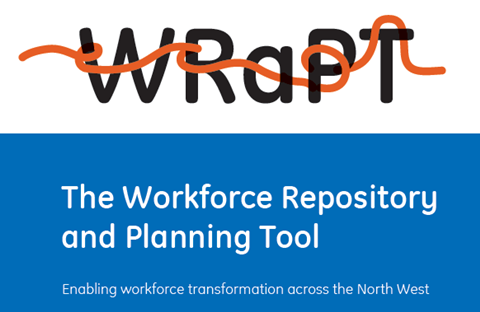A set of tools facilitating the collection and modelling of workforce data across systems are driving improvements in care quality, writes Colin Lewry
In the run up to Christmas 2013, staff from Lancashire Care Foundation Trust, Health Education England and GE Healthcare Partners gathered to discuss how to drive workforce redesign across the increasingly complicated landscape of health and social care systems.

That initial discussion has evolved into the development of WRaPT – a powerful set of tools that facilitates the collection and modelling of workforce data across systems, backed by approaches, training, good practice, and a dedicated team of staff. The collaboration is still going strong, and was Highly Commended in the inaugural HSJ Partnership Awards in 2018.
Capacity and activity
The Workforce Repository and Planning Tools, WRaPT, are available free from Health Education England. WRaPT is ideal for anyone within a system or organisation who is responsible for workforce planning in the health or social care setting. At its core, the tools and approach establish a relationship between workforce capacity and required activity, and provide the information needed to meet the significant challenges of current trends, including:
- An aging population placing greater demands on overworked providers.
- A reducing workforce and staff shortages.
- Limited financial resources.
To address these issues, greater integration between organisations, delivering new models of care, is required. Yet for many charged with these responsibilities, it is difficult to gather, analyse and share the right data while maintaining information security.
As many systems and organisations have already discovered, WRaPT supports redesign at strategic and operational levels. The tool has two essential functions: a safe place to store data, and a mechanism for modelling change.
A number of organisations have used it to guide workforce planning and decisions, including a hospital in the North West of England
The repository allows the collection and analysis of workforce and activity data, and matching between the two. It helps planners do things like identify the workforce that delivers radiology activity across the region, and build scenarios by changing activity, workforce and efficiency levels to understand the workforce resources required if activity levels change or move between teams, systems or organisations. It can examine options if efficiency levels increase or if new services are commissioned.
The first version of the system was deployed in 2015, and it has been revised and updated twice since that time, with another version available this spring. A number of organisations have used it to guide workforce planning and decisions, including a hospital in the North West of England.
Due to shortages, the facility had struggled to recruit and retain acute medical registrars, and to ensure proper coverage the hospital had to pay premium rates for senior decision makers. The hospital used WRaPT to explore the feasibility of replacing those positions with advanced nurse practitioners who would receive additional training.
Findings indicated that even though it would be necessary to increase the number of ANPs by 40 percent, using advanced nurse practitioners would result in a savings of £1.5m – a more cost effective approach. In addition, this would enable staff members to enhance their skills and potentially work in other areas of the hospital.
The tool and approach is being used in many other ways to address a diverse array of issues. As part of a project to improve trauma services, a hospital in the North of England used WRaPT to determine how many radiographers would be required to operate CT scanning around the clock, as well as insights into how increased demands for CT, ultrasound and MRI scans have impacted the radiology workforce.
Due to increased demands on urgent and emergency care services, another hospital is using WRaPT as a mechanism to collect and analyse workforce and activity data for cardiology pathway redesign.
Process providing support
WRaPT is more than a set of tools; it’s also a process with a team of people to provide support and help users learn how to use them. It requires three sets of data: the workforce, activity and “drivers”, that explain how staff split their time between different activities. Because most organisations don’t have this information readily available, it is often necessary to agree to certain assumptions.
Once this is complete, it is possible to explore the workforce data, and then define and test the impacts of changes in the model of care.
There are other advantages to using WRaPT:
- Data-based decision making from the onset of transformation initiatives.
- The ability to test different ideas to generate an evidence-based strategic model that encompasses the size, shape and cost of the required workforce.
- Information can be used to improve efficiency and produce benchmarks to compare performance between teams.
- The ability to model and record staff requirements of new hospitals or services, as well as business units.
WRaPT offers a safe place to manage data, allows clinicians and managers to engage in redesign and provides a solution that can take you from “I have no idea how to get started” to a clear set of workforce redesign plans.
From its Christmas origins in a room with a few people, WRaPT is improving care quality through workforce planning: providing a process, a set of tools and, if needed, a team to help systems and individual organisations transform health and social care through data-based workforce planning. For more information visit wrapt.org.uk.





























No comments yet